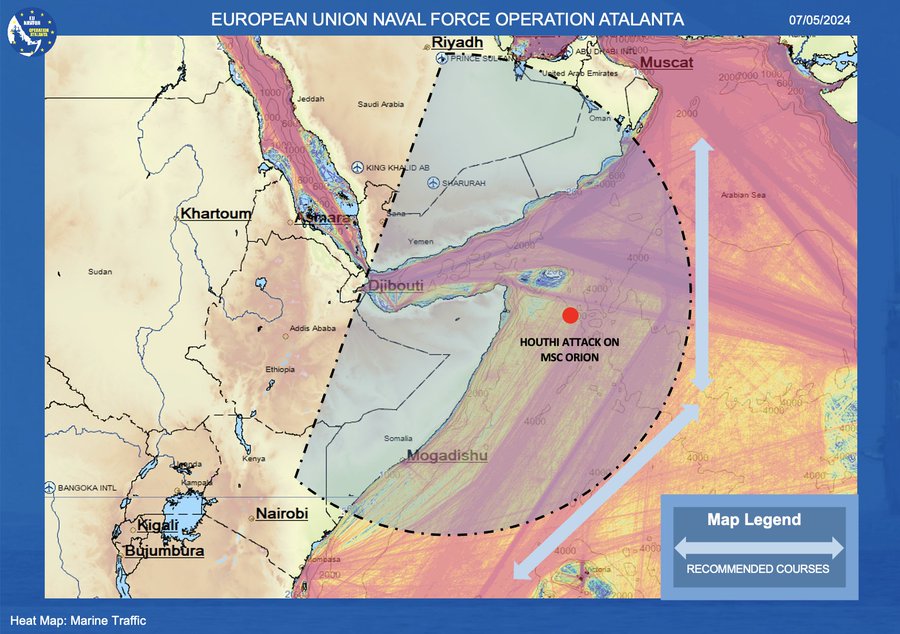In the wake of the declared failure of American and European efforts to curb Yemeni maritime operations supporting the Palestinian people, the European Union (EU) acknowledged this week the expanding threat to ships linked to Israel, the United States, and Britain in the Indian Ocean. The EU warned these ships against sailing near the new operation area, as maritime shipping experts continue to affirm that Yemeni operations are escalating and that the military presence of Western forces has failed to hinder this trajectory.
The official website of the EU’s “Atalanta” maritime operation published a memo this week advising “ships sailing off the Indian Ocean to maintain a high state of alert” in light of what it described as “the recent escalation” of Yemeni attacks using drones in the Indian Ocean.
The EU memo included a map that illustrated the expansion of Yemeni maritime operations to the Indian Ocean, covering a wide area that includes the island of Socotra and its surrounding maritime region, the maritime area opposite the entire Somali coasts, and extending to the north of Madagascar.
The EU memo referred to the qualitative operation that the Yemeni armed forces announced they had carried out at the end of last April, which targeted the Israeli ship “MSC Orion” in the Indian Ocean.
The memo stated that “the ship (MSC Orion) was targeted by a drone at a distance of 200 nautical miles southeast of Socotra Island, while the ship was passing through the Indian Ocean heading north towards Salalah (Oman).”
It added that “this attack confirms that potential attacks can occur in the Indian Ocean at a distance of up to 800 nautical miles” from the free zones controlled by the Yemeni armed forces.
The memo suggested “establishing an alternative sea route at least 150 nautical miles east of the current traffic routes.”
The map included in the report clarified the new route, where ships are supposed to avoid approaching the area surrounding Socotra and the area opposite the Somali coasts (at a distance of about 700 nautical miles) and are forced to pass between the depth of the Arabian Sea and the north of Madagascar.
However, the new route identified by the map is not considered safe for ships heading towards Israel; the danger zone specified in the map is a very large area confirming that the Yemeni armed forces possess advanced capabilities that can reach far distances that cannot be measured based on only one attack.
In April, the Yemeni armed forces announced the targeting of the Israeli ship “MSC Grace F”, and tracking sites showed that it was sailing off the coasts of Kenya at a distance far exceeding the range identified by the map of the European “Atalanta” operation.
This was also confirmed by the other recommendation included in the EU memo, which advised ships “to practice random modifications on speed and course and adopt a more restrictive policy for the Automatic Identification System” which is a reference to falsifying electronic information of the ship such as its identity and destination. This recommendation indicates that the alternative route proposed by the EU for ships in the Indian Ocean is not sufficient to avoid Yemeni operations, and that targeted ships must also falsify their data.
Despite this, the process of falsifying the data of the Automatic Identification System for ships has already proven to be ineffective, as the armed forces have been able to target enemy ships over the past months that had changed their course information, turned off their identification devices, and even resorted to changing their ownership data to cover up their association with Israel or America and Britain.
In April, the “Hellenic Shipping News” newspaper, specialized in maritime transport affairs, quoted Gabriel Fuentes, Assistant Professor of Shipping Economics and Analyst at the Norwegian School of Economics, as saying: “Changing the data of the Automatic Identification System for ships is not an effective way to avoid attacks, and finding ways to avoid Yemeni attacks and mitigate their risks is complex; due to the unexpected nature of these attacks,” according to him.
The EU memo also said that “it is important for ships operating in the west of the Indian Ocean and the Gulf of Aden, especially those located within a distance of 700 nautical miles from the Somali coast, to comply with the recommendations, and to report any incidents immediately.”
This memo represents a clear acknowledgment that the Indian Ocean has become a major theater for Yemeni operations supporting Gaza, and that ships that Israel relies on to pass through that region become increasingly exposed to danger over time; which means that shipping companies may soon turn to stop shipping operations to enemy ports via the Cape of Good Hope route as they did in the Red Sea route; which will have significant additional implications for the enemy’s economy.
The new European memo comes in the context of an official acknowledgment of the inability recently expressed by the commander of the “Aspides” operation affiliated with the EU, which was launched last February to support the American enemy in an attempt to curb Yemeni operations and protect Zionist navigation, where the European commander said: the operation no longer has enough warships to continue to confront Yemeni attacks after several European frigates withdrew one after the other.
In this context also, the Danish “Shipping Watch” website, this week, quoted Lars Jensen, a prominent expert in the maritime shipping industry and former official at Maersk, as saying: “Despite the operations of Guardian of Prosperity (American) and Aspides (European), the data coming from the Maritime Security Center in the Horn of Africa shows a very clear increasing trend in the number of attacks” according to what the Danish “Shipping Watch” website specialized in maritime navigation affairs reported.
Jensen added that “if the goal (of the American and European operations) is to reduce the risks of Yemeni attacks then no progress has been made” according to what the site reported.
He said: “The data clearly shows that the volume of attacks is steadily increasing despite the military presence,” indicating that about 132 attacks with missiles and drones have been recorded since last November according to data from the Maritime Security Center in the Horn of Africa.







